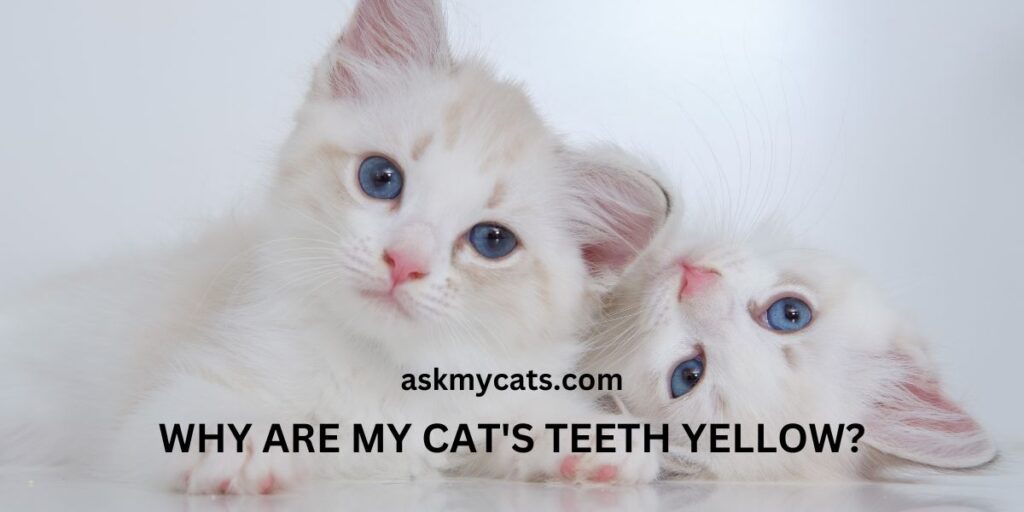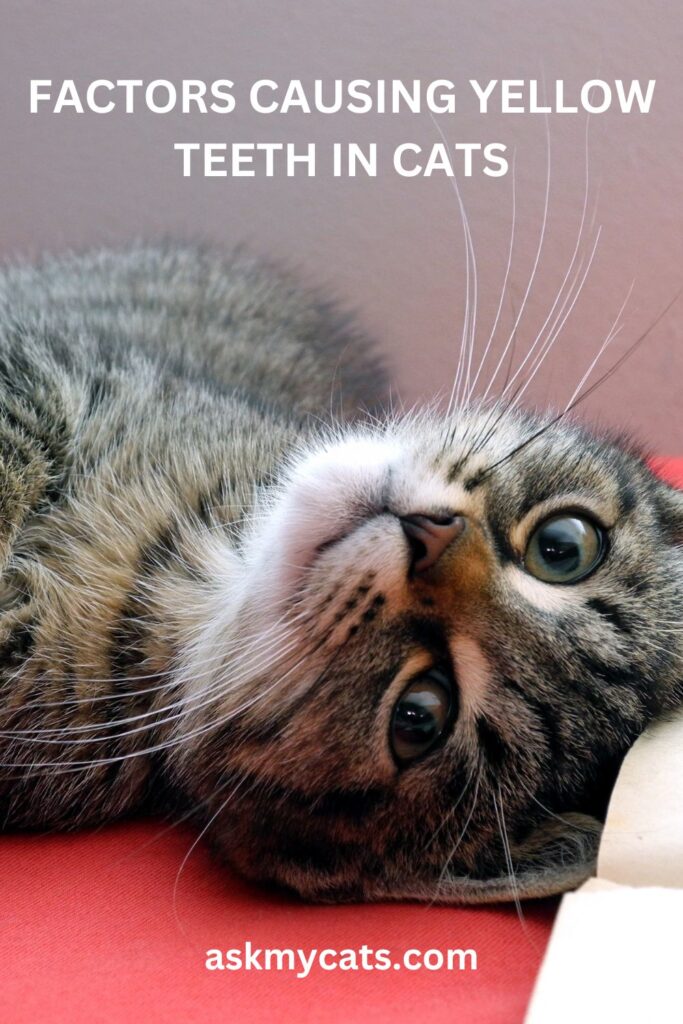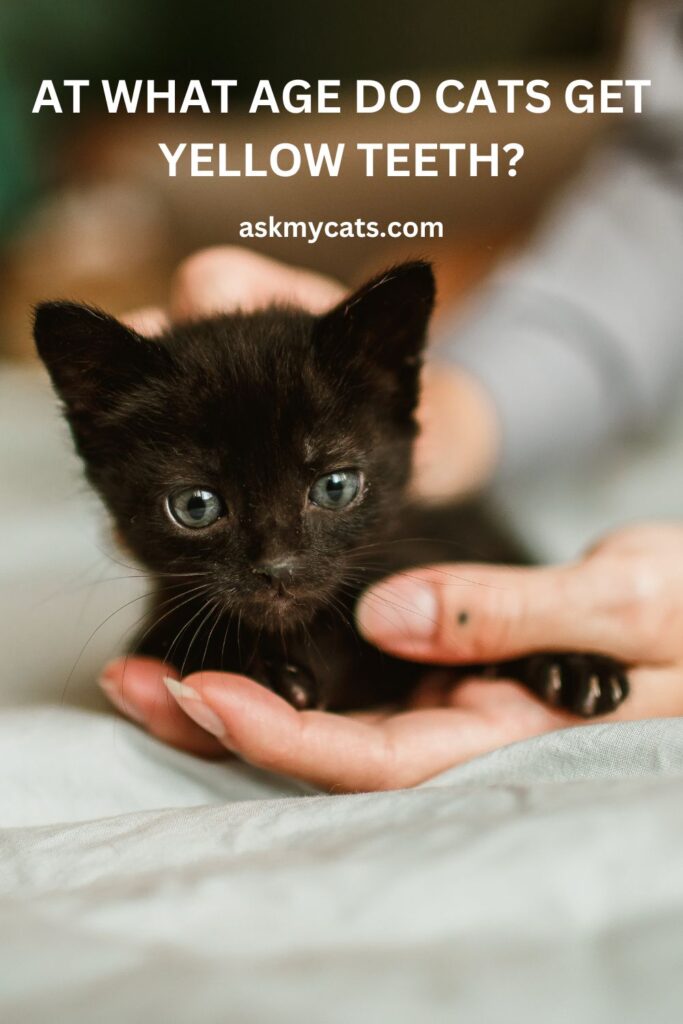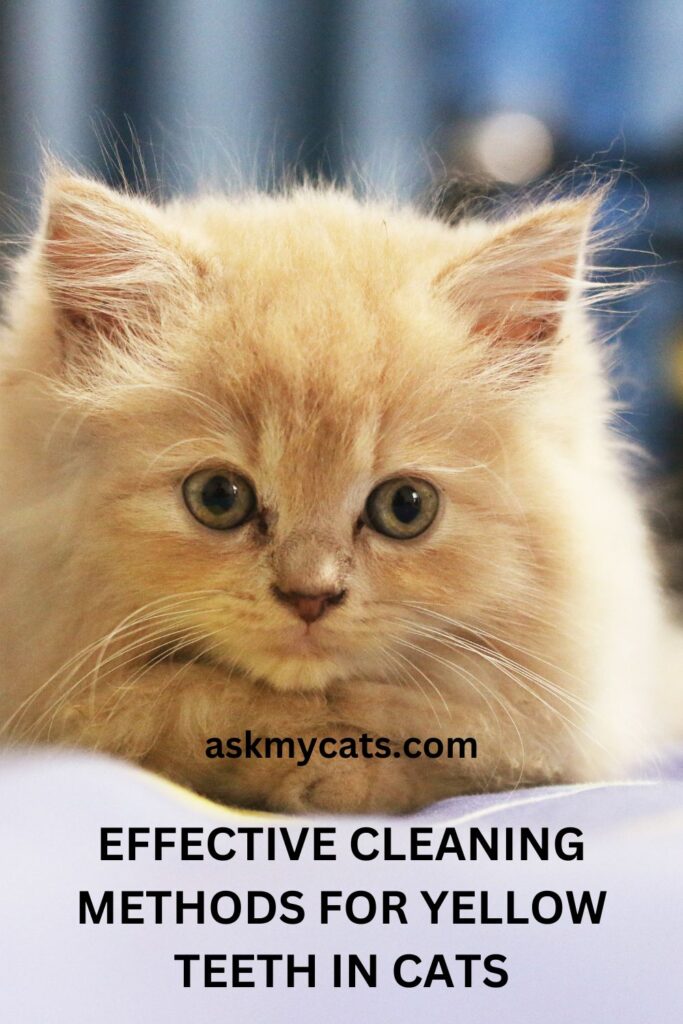Are you concerned about your cat’s yellow teeth? Just like humans, cats can experience dental issues that affect their oral health.
In this article, we will explore the reasons behind yellow teeth in cats, whether it’s a normal occurrence, and most importantly, how you can effectively address and prevent this problem.
Key Takeaways
- Plaque and tartar build-up are common causes of yellow teeth, leading to bad odor, inflammation, and increased risk of dental infections.
- Yellow teeth can also be a symptom of underlying dental diseases, such as inflamed gums or difficulty eating.
- Cats of any age can develop yellow teeth, but it’s more common in senior cats due to dental care challenges.
- Regular teeth cleaning, dental treats, and additives can help prevent yellow teeth in cats.
- Neglected yellow teeth can lead to periodontal disease, tooth loss, and potential organ damage.
- Early treatment and dental check-ups are crucial for maintaining your cat’s dental health.


Give Your Cat the Perfect Day
Get the Free Ebook!
Is It Normal for Cat Teeth to Be Yellow? Understanding Cat Teeth Color
Often, the color of your cat’s teeth can be the first indication of the dental health of your cat. Cats tend to have teeth in a range of colors from white to off-white, and yes, sometimes even pale yellow.
What you need to observe, if your cat’s teeth are yellow, is that there shouldn’t be any additional problematic symptoms associated with it.
Moreover, a very strong yellow color of the teeth can indicate discoloration, which happens due to some underlying dental health problem.
Factors Causing Yellow Teeth In Cats

There are several different factors that can cause discoloration in your cat’s teeth and make them yellow.
However, before jumping to a conclusion about the cause, you should look at the symptoms in your cat that are associated with that discoloration of teeth.
The three main causes of yellow teeth in cats are:
- Plaque Build-up
This is one of the most common reasons behind yellow teeth in cats. It is the initial indication that the dental health of your cat is not being maintained. Plaque build-up is often associated with bad mouth odor. - Tartar Build-up
If the plaque build-up in cats is not treated in a timely manner, then it can harden and form tartar. Tartar build-up is often accompanied by yellow discoloration, bad mouth odor, inflammation, and an increased risk of dental infections. Your cat may experience pain and discomfort in its mouth if it has tartar build-up on its teeth.
Interesting Read: Home Remedies for Cat Tartar Removal - Dental Diseases
Finally, yellow teeth in cats can often be the first symptom of an underlying dental issue. In this case, you need to observe if your cat is having inflamed gums, bleeding gums, difficulty in eating, constant irritation in their mouth region, or any other such unusual symptom.
If the yellow color of your cat’s teeth doesn’t improve with brushing and dental hygiene, you should take your cat to the vet and have it checked for any underlying dental health conditions.
At What Age Do Cats Get Yellow Teeth?

Much like in humans, yellow discoloration of teeth in cats is also not dependent on the age of the cats. Cats of any age can develop yellow teeth.
However, it is more common to find yellow teeth in senior cats because as they age, they become less comfortable being forced through any kind of routine. So, it becomes understandably difficult to brush your older cat’s teeth.
Moreover, since they tend to get weaker with age, giving them dental treats that are hard to chew and that remove plaque build-up also becomes a little difficult.
The only easy option that remains is to add dental additives to your older cat’s water.
This yellow discoloration in older cats can be avoided if they are made used to brushing their teeth from a young age.
Additionally, regular teeth cleaning procedures and dental checkups can also help to keep the dental health of older cats in prime condition.
Interesting Read: The Importance of Teeth Cleaning for Older Cats
Effective Cleaning Methods For Yellow Teeth In Cats

If your cat has yellow teeth, the first thing you need to do is find the underlying cause.
Taking your cat to the vet in case of yellow teeth is the best way to not only figure out why your cat has yellow teeth but also to figure out how to go about treating it.
If your cat has plaque or tartar build-up, then a complete teeth cleaning procedure will be required to clean your cat’s teeth and remove the yellow discoloration.
However, if your cat has yellow teeth because of some underlying dental disease, then a course of treatment will be prescribed.
Treating dental diseases goes beyond just teeth cleaning and involves a course of medication and a suggested change of dental routine for cats. This is done to manage the symptoms, treat the disease, and ensure that it doesn’t recur in cats.
Must Read: How to Brush a Cat’s Teeth: Step-by-Step Guide
Preventing Yellow Teeth In Cats
It is very cliché and very true that prevention is, indeed, better than cure. To prevent your cat’s teeth from turning yellow, you should develop a proper dental care routine for your cat. This includes:
- Regular (preferably daily) brushing of your cat’s teeth
- Giving dental treats and dental toys to your cat every now and then
- In case of bad mouth odor or inability to brush your teeth daily, consider adding dental additives to your cat’s water
- Regular dental checkups and an annual teeth cleaning procedure can ensure that your cat’s dental health is in the best condition
- Encouraging proper hydration can also go a long way in ensuring not only the dental but overall health of your cat
Interesting Read: How to Keep Your Cat’s Teeth Clean Without Brushing?
How Yellow Teeth In Cats Can Lead To Organ Damage If Left Untreated
On the face of it, yellow teeth in cats may not seem like a big issue. But if you don’t figure out the underlying cause and treat it swiftly, in some cases, the yellow teeth of your cat could lead to more serious issues like organ damage.
What basically happens in any dental issue in cats is the formation of bacteria in the mouth. So, whatever may be the reason behind your cat’s yellow teeth – plaque, tartar, or any other disease – there’s going to be bacterial formation at play.
If you don’t treat this bacterial formation quickly, it can eventually lead to a more serious condition called periodontal disease. In this disease, the teeth of the affected cat become loose and weak. Some teeth may also fall off.
Because of this loosening of the teeth of the affected cat, the bacteria can enter the bloodstream of the cat and cause more serious issues like organ damage.
This is why, when it comes to yellow teeth in cats, it is always better to err on the side of caution and schedule a dental check-up to treat the yellow discoloration as soon as possible. Because the discoloration goes beyond just a change in color.
Check Out: How Much Does Cat Teeth Cleaning Cost?
Frequently Asked Questions
Which organs of a cat can get damaged due to untreated dental issues?
The heart, kidney, or liver of a cat can get damaged if the dental issues are not treated and bacteria enter the bloodstream.
Can yellow teeth in cats lead to tooth loss?
Yes, yellow teeth in cats can lead to periodontal disease, which causes the loosening and weakening of teeth in cats. This can soon lead to tooth loss.
What are some common dental issues that can lead to yellow teeth in cats?
Some common dental issues in cats that can lead to yellow teeth are plaque, tartar, gingivitis, periodontal disease, and tooth resorption.
What are some problematic cat teeth symptoms that indicate underlying disease?
Apart from yellow teeth in cats, some other symptoms that indicate an underlying dental disease include reddened gums, drooling, bad breath, and difficulty eating.
At what age do cats often experience dental issues?
A study by Cornell University suggests that about 50 – 90% of cats over the age of 4 years start experiencing frequent dental issues.
Final Words
Yellow teeth in cats always need to be checked by a vet to ensure that there isn’t any serious underlying dental issue.
This can be prevented by having a regular dental care routine for your cat, that includes regular (preferably daily) brushing, occasional dental treats, dental toys that remove plaque build-up, and dental additives added to the water of your cats.
Remember that yellow teeth are often the first symptom of a dental issue that needs medical attention. Leaving it untreated can lead to more severe consequences like tooth loss or even organ damage.
References
- https://www.hillspet.com/cat-care/healthcare/cat-dental-care
- https://www.petcoach.co/question/?id=649299
- https://www.petmd.com/cat/conditions/mouth/dental-issues-cats
- https://vcahospitals.com/know-your-pet/dental-disease-in-cats
- https://www.vet.cornell.edu/departments-centers-and-institutes/cornell-feline-health-center/health-information/feline-health-topics/feline-dental-disease

I was very worried about my adopted cat’s dental health. I am only thirteen so my parents don’t want me to spend money on a vet visit. Doing some online research. All the blogs I read on PetCareRx, PetMD, and this one suggests my cat might have periodontal disease. Looks like I have to save up money to get Bella to a vet soon!!
Hey there,
I can totally understand your concern about Bella’s dental health—it’s great that you’re being so responsible and looking out for her! I’ve been through something similar with one of my own cats, and I know how tough it can be when you’re worried and trying to figure things out.
First off, it’s awesome that you’re doing your research and trying to learn more about what might be going on. Periodontal disease is something that a lot of cats can develop, especially as they get older, so you’re right to want to take action.
If Bella is showing signs like bad breath, drooling, or if she seems to be having trouble eating, those can be red flags. It’s definitely important to get her checked out by a vet when you can. In the meantime, there are a few things you can do to help her at home:
– **Brush her teeth**: I know this can be tricky, but even just trying to brush a few times a week can make a big difference. There are special cat toothbrushes and toothpaste that are safe for them (just make sure it’s for cats and not for humans!).
– **Dental treats or toys**: Some treats are designed to help clean teeth, and there are toys that can help with dental health too. They’re not a replacement for a vet visit, but they can help a bit until you can save up.
– **Keep an eye on her behavior**: If Bella starts to show signs of pain or stops eating, it’s really important to get her seen as soon as possible, even if it means talking to your parents again about how serious it could be.
Saving up for a vet visit is a great plan, and maybe you could talk to your parents about it again—sometimes showing them what you’ve learned and how concerned you are might help them see why it’s so important.
I’m really impressed by how much you care for Bella, and I’m sure she’s so lucky to have you looking out for her! Hang in there, and I hope you can get her the care she needs soon.